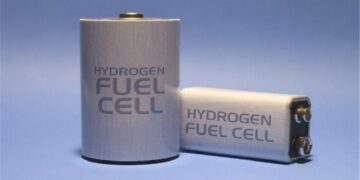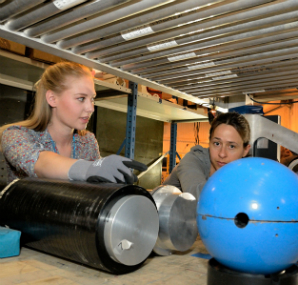Los Alamos National Laboratory will assist Toshiba in developing a muon tracker for use helping decommission the Fukushima Daiichi nuclear power plant.
Muon radiography (also called cosmic-ray radiography) uses secondary particles generated when cosmic rays collide with upper regions of Earth’s atmosphere to create images of the objects that the particles, called muons, penetrate. The process is analogous to an X-ray image, except muons are produced naturally and do not damage the materials they contact. Muon radiography has been used before in imaginative applications such as mapping the interior of the Great Pyramid at Giza, but Los Alamos’s muon tomography technique represents a vast improvement over earlier technology.
In developing muon tomography, Los Alamos researchers found that by placing a pair of muon detectors in front of and behind an object, and measuring the degree of scatter the muons underwent as they interacted with the materials they penetrated, they could gather detailed images. The method works particularly well with highly interfering materials (so-called “high Z” materials) such as uranium.
Because the muon scattering angle increases with atomic number, core materials within a reactor show up more clearly than the surrounding containment building, plumbing and other objects. Consequently, the Los Alamos muon tomography method shows tremendous promise for pinpointing the exact location of materials within the Fukushima reactor buildings.
“Los Alamos researchers began working on an improved method for muon radiography within weeks of the 2011 earthquake and tsunami that damaged the Fukushima reactor complex,” said Christopher Morris, chief scientist and leader of the Los Alamos Muon Tomography Team. “Within 18 months we had refined our technique and published a paper showing that the Los Alamos method was superior to traditional muon radiography techniques for remotely locating and identifying nuclear materials, and that it could be employed for field use.”
Los Alamos’s muon tomography technology also has the potential to be deployed in locations around the world to help detect smuggled nuclear materials. In fact, Los Alamos previously granted an exclusive license to Decision Sciences International Corporation for broad commercialization of the Los Alamos technology. The company has successfully deployed portal monitors that use muon tomography at a major seaport for cargo-container scanning as well as at other locations under their licensing agreement.
Muon tomography and development of its application at Fukushima was made possible in part through Los Alamos’ Laboratory-Directed Research and Development Program (LDRD), which uses a small percentage of the Laboratory’s overall budget to invest in new or cutting-edge research. The U.S. Department of Energy supported contacts of the Los Alamos team with other research groups, including several Japanese institutions and the University of Texas.





































